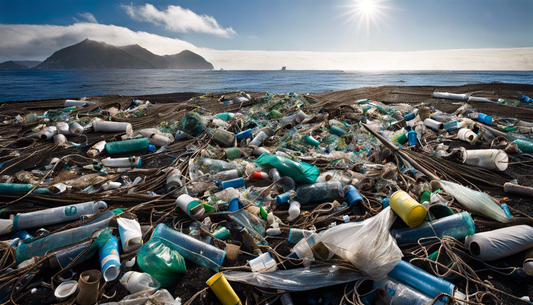Share
Greenwashing is a phenomenon that involves making a product or company seem more environmentally friendly than it is.
Over recent years, politicians, social activists, environmentalists, and government organizations have been pressing over the need for sustainability. The most pressure is faced by corporations.
Under such circumstances, companies should understand the importance of authentic sustainability and how they can avoid greenwashing.
Read our article on Greenwashing vs. Greenhushing
Ever heard of the 7 Sins of Greenwashing?
Sustainability in the corporate world has become a necessity. Consumer trends have changed, and consumers are more likely to purchase products that are made through sustainable processes and are environmentally friendly.
Sustainable products have experienced 2.7X faster growth than non-sustainable products. Moreover, market experts claim that corporate responsibility practices boost sales by 20%.
Moreover, people are also well aware of greenwashing and avoid doing business with entities that are involved in it.
In this article, we will discuss some ways how businesses can avoid greenwashing and why it’s important to stay true to their commitments to sustainability.
Key Strategies To Avoid Greenwashing
1. Begin By Setting Clear Sustainability Goals
Having a clear vision for sustainability is the key first step when creating a genuine environmental campaign. Without well-set targets, businesses become imprecise, and greenwashing might come into play by making generalized statements concerning their environmental activities.
Example:

A good example of a corporation clearly defining its sustainability targets is Nike.
Their sustainability campaign is known as Move to Zero. By 2025, the company aims to achieve the following:
- 5M tons less greenhouse gas emissions by increasing the use of environmentally friendly products.
- 100% of waste diverted from landfill in supply chain with at least 80% of waste recycled back into Nike products.
- 25% reduction of freshwater usage per kilogram in textile dyeing and finishing.
While the company’s campaign has been criticized for falling short of necessary ambition, the defined goals are specific, measurable, realistic, and time-bound.
2. Be Transparent and Upfront About Business Practices.
Transparency is one of the most important elements that enables building trust with consumers and stakeholders. By providing information on their sustainability practices transparently, businesses can prove their accountability and credibility.
Example:

Patagonia, an outdoor apparel and equipment company, has earned a reputation for its transparency in environmental and social performance.
The company facilitates the accessibility of its website through the provision of detailed information about the environmental impact of its products, such as material sourcing, manufacturing processes, and supply chain transparency.
Such transparency allows consumers not only to purchase products with confidence but also to recognize Patagonia's commitment to sustainable practices.
3. Avoid Exaggerated Claims
Overstated or misleading sustainability claims will quickly diminish consumer trust and ruin the company’s reputation.
It's crucial for companies to use solid data as a basis for their statements; otherwise, neither of them can be trusted.
Example:

In 2017, the Volkswagen scandal came to light when it became apparent that the company had been manipulating the emission tests for its diesel vehicles.
Even though the company advertised its diesel engines as "clean diesel," Volkswagen put software on the cars to cheat emissions tests, resulting in severe damage to the environment and loss transparently of consumer trust.
This scandal is the greatest example for overstating claims of sustainability in combination with significant fraud.
Not only did the scandal damage consumers and the environment. It also has cost the company more than $34 billion and damaged the whole industry by putting the Diesel engine on a slow road to oblivion.
4. Seek Third-Party Certifications
The third-party certifications are the testimonies to the sustainability practices of the company, and they are the evidence to prove the company's environmental claims.
Through being certified by trustworthy agencies, enterprises show that they are ready to adhere to the rules and regulations.
Example:

One leading third-party certification is the Forest Stewardship Council (FSC), which certifies the wood and paper that are produced from responsibly managed forests.
Organizations such as IKEA and Kimberly-Clark have acquired FSC certifications for many of their products.
With this certification, consumers are made aware that their purchase is supportive of sustainable forestry practices.
Likewise, the Fair Trade Certified label is an example of products that are required to meet strict social, environmental, and economic standards.
Brands such as Ben & Jerry’s and Patagonia have adopted fair trade certification as a way of letting the public know that they are serious about ethical sourcing and production.
5. Do Not Misuse Images in Ads and Packaging
The visuals in ads and packaging are potent drivers of consumer perception, and companies need to make sure that they show the actual green practices that they apply.
False "eco-friendly" impressions can be given by images that are misleading, such as the color green or nature, unless accompanied by concrete sustainability efforts.
Example:

Nestle, one of the world’s largest food and beverage companies, unveiled its latest ad campaign promoting its Pure Life bottled water with a newly-shaped bottle design, claiming that it is 100% recyclable.
Nestle's advertising relied heavily on pictures of vibrant green landscapes, water droplets, and recycled signs with green tags and labels that read "eco-friendly" and "environmentally conscious."
These images were meant to tell the audience that the Eco-Bottle was a sustainable option that people who are concerned about the environmental impact should choose.
However, environmentalists have raised the point that no plastic bottle is 100% recyclable in practice.
According to research, only 29% of the plastic bottles are currently recycled in America. This makes plastic bottles as one of the most polluting items in the world.
Difference Between Green Marketing and Greenwashing
Green marketing and greenwashing are different. Green marketing is a strategy that helps consumers understand how using environmentally friendly products can benefit them.
Greenwashing is the unethical practice of companies making false claims about their environmental efforts.
The distinction between green marketing and greenwashing is extremely thin. While greenwashing implies that companies sell their products or services on the basis of false environmental benefits, green marketing is the process of selling products and services based on the genuine environmental advantages they possess.
Green marketing is generally practical, honest, and transparent, and it means that a product or service meets the following criteria: Green marketing is generally practical, honest, and transparent, and it means that a product or service meets the following criteria:
- Manufactured with eco-friendliness in mind.
- No toxic, ozone-depleting substances are used.
- Recyclable or derived from recycled material
- Composed from renewable origin.
- Not using items that are derived from an area that is protected or has an impact on the threatened and endangered species when they are harvested.
- Not produced with slave labor or by the people who are not receiving proper wages.
True Sustainability Pays Off
Genuine sustainability has always payed off businesses by boosting their sales and profits. If companies truly contribute towards environmental sustainability then they can enjoy some great benefits in terms of business growth.
We hope you enjoyed this article. If you want to read more like this, make sure to check out our Blog and follow us on Instagram. If you are interested in truly sustainable products, check out our Shop.
Leave a comment below and engage in the discussion!








